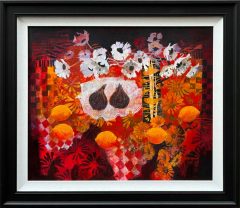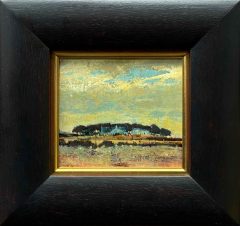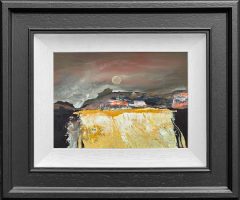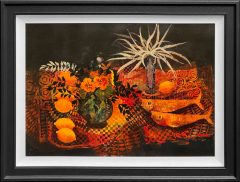Gordon Hope Wyllie (1930-2005)
Showing all 4 results
-

Gordon Hope Wyllie – Lemons & Flowers (New In)
£3,499 -

Gordon Hope Wyllie – Evening Light (Sold)
-

Gordon Hope Wyllie – Autumn Moon (Sold)
-

Gordon Hope Wyllie – Still Life (New In)
£3,999
Gordon Hope Wyllie
Gordon Hope Wyllie (1930-2005)
Gordon’s interest in the Scottish countryside can be traced back to his earliest childhood memories. Family rail and steamer excursions courtesy of the free and subsidised rail travel that his father’s job on the railways allowed. These early travels gave him a love and intimate knowledge of his native Scottish landscape that has remained with him all his life.
However on leaving school after the War, Gordon joined the newly formed Welfare Department of Greenock Corporation. His subsequent experiences in dealing with the mentally ill. The homeless and the underprivileged in this austere period of post war Glasgow led him to re-evaluate his own priorities. A planned university career in Mathematics was abandoned in favour of a place at Glasgow School of Art.
Gordon spoke highly of the School and his experiences there. “There was a lot of plain speaking about for it was in the years before the advent of gobbledygook. I suppose criticism might be levelled against the place that we were not introduced to the most up to date movements in Art. But we were certainly given the technical equipment to develop ourselves in due course”. He was taught life drawing by Edward Odling and significantly came under the influence of the great Mary Armour. A formidable character and excellent teacher who became, with her husband, close friends of Gordon later in life.
EDUCATION
Graduating in 1953. Gordon was subsequently awarded the Post-Diploma or Masters course and in the same term he won both the Royal Scottish Academy Award. And the most prestigious award of the School. The Newbery Medal. That year he was also awarded the scholarship to study at Hospitalfield College of Art in Arbroath, a highly respected summer school, then under the direction of Ian Fleming RSA. The experience had a profound effect on the young student’s painting, to Gordon the landscapes of the Angus countryside and the fishing villages along the coast were a revelation.
“The whole atmosphere was totally different from what I had been used to in the West. And the light was completely different. Fleming was a great talker and he encouraged us all to follow our own particular ways of developing. He certainly encouraged me to think about the abstract qualities of the harbour scenes and it was at that point that I began to think about the colours and the tones and textures abounding along the coast. I came away from that place with a completely different notion of what I was going to do.”
ABSTRACT PAINTINGS
Inspired with a new artistic vision Gordon began to paint large scale abstract works which met with little commercial success, The Scottish public still struggling with an understanding of Impressionism and Post Impressionism in the early nineteen fifties.
The untimely death of his father left Gordon with new responsibilities. Forcing him to give up his postgraduate studies and a travel scholarship in favour of a regular salary. Becoming a teacher, Gordon joined that generation of his profession that became largely responsible for the renaissance in art that began to appear in Scotland from the 1960s onwards. This phenomenon he attributes to the practice of teachers continuing to paint actively while teaching full time. For many years Gordon served on the examination board. Culminating in his appointment as Principal Examiner in Art & Design for Scotland. Which was an influential position that he held for ten years.
The construction and composition of the land that sparked his early interest in abstraction has developed into a fascination with the ever-changing colours, textures and patterns of Argyll and Kintyre in the West. Gordon had a great passion for croft houses that. “Seem to have grown out of the landscape” in the area. an enthusiasm tempered only by a concern for their future.
“The ‘discovery’ of white paint has transformed most of our ‘wee hooses’. Over the last half century yet they are still absolutely right in their settings. Alas, it will not always be so for they are now an endangered species and all over Scotland. Finding bungalows and houses that seem to be alien to this land and more suitable to the South than here.” Gordon’s richly textured jewel-like images are a lovingly crafted record of these isolated local communities.
Various paintings by Gordon Hope Wyllie are in public collections.


